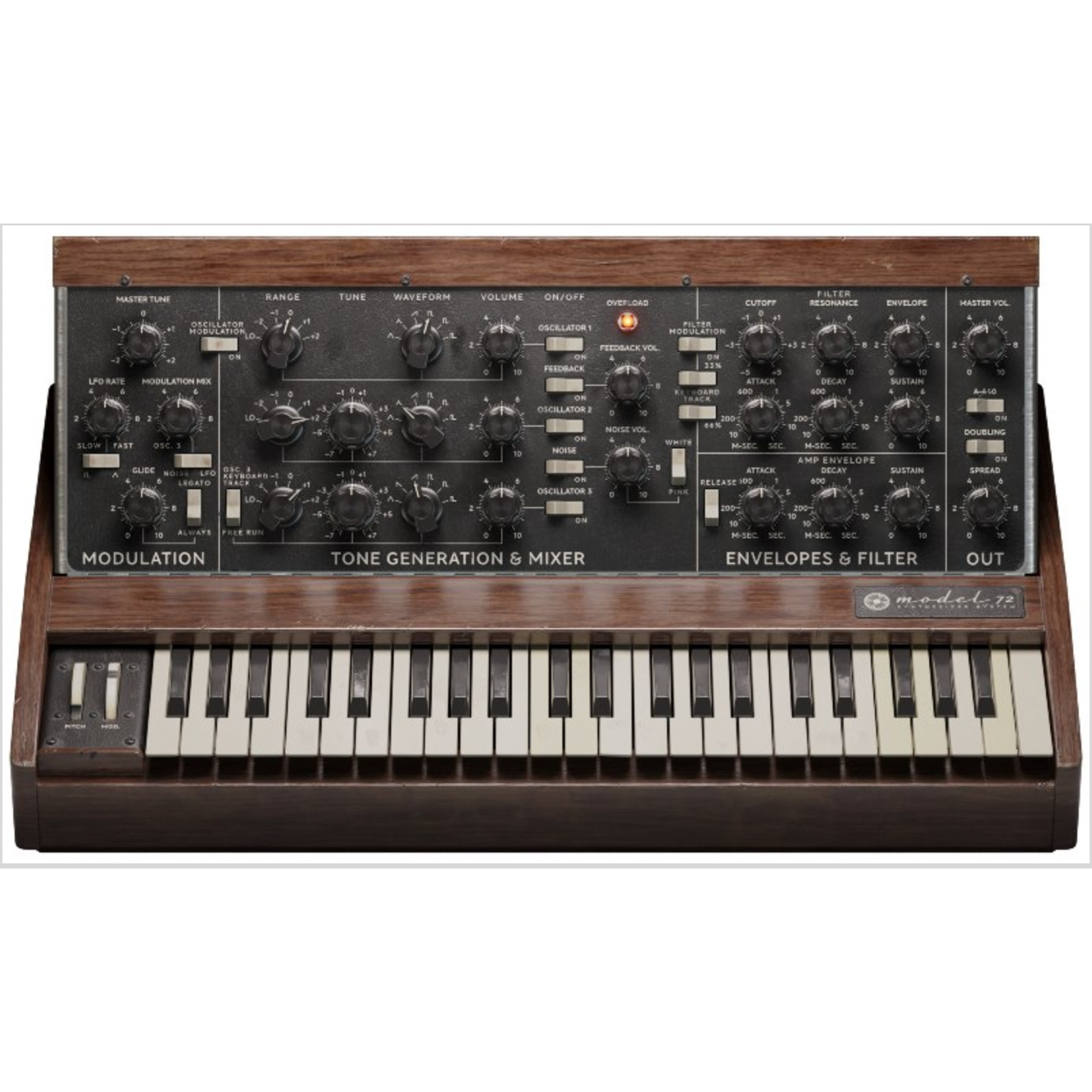Best synth plugins 2025: Synth VSTs to suit all styles and budgets
From virtual analogue to wavetable, these are plugins you need on your hard drive
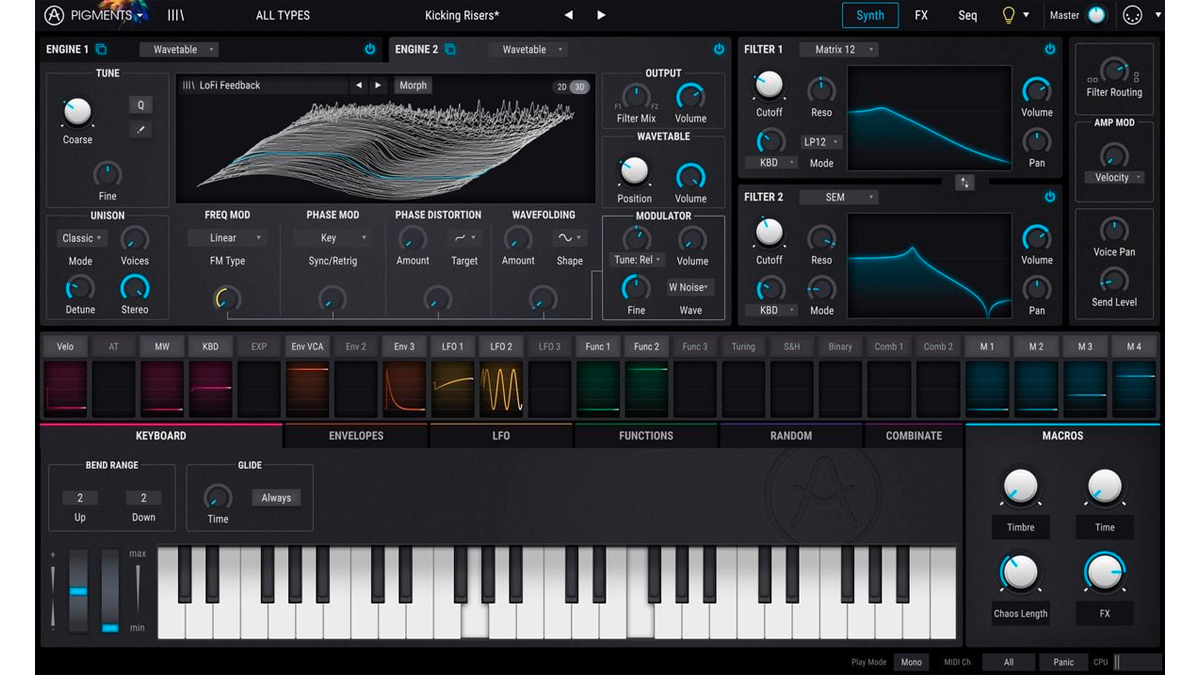
For some musicians, the best plugin synths are the ones that come with their DAW, as they won't cost them anything over and above what they've already paid for their music production software.
However, many others choose to augment these built-in soft synths with third-party plugins - add-on instruments that either be purchased or, in some cases, downloaded for free.
In many ways, these work just like the hardware synthesizers that you’ll be familiar with, but they run in software instead of coming in a physical box. Some software synths are emulations of hardware models - recreations of vintage keyboards are particularly popular - but others are completely original.
You’ll hear software synths being referred to by a variety of different names - virtual instruments, software instruments or just plain old VSTs - but on a basic level, they all operate in the same way.
Once installed on your PC or Mac, each plugin synth can be loaded onto its own track in your DAW, enabling you to play and record it using your MIDI keyboard or other MIDI controller.
You can also program notes for it to play using your mouse, and each synth will come with its own set of controls for adjusting the sound.
Typically, you’ll find banks of presets, too: pre-programmed sounds that can simply be loaded up and played or used as starting points for further editing and sound design.
Best synth plugins: MusicRadar's choice
Trying to decide on one outright ‘best synthesizer' is like trying to make a definitive call on what the best type of food is - there are so many fantastic choices out there, and much of what makes any of us prefer one over another comes down to personal taste.
That being said, if your budget only stretches to a single synth plugin and you want something that will cover a lot of bases, Arturia Pigments is probably the best all-rounder out there right now. It’s relatively affordable and accessible in its design, but there’s plenty of depth to get stuck into once you venture beyond the presets, making it suitable for beginners and advanced synthesists alike.
For those on a tighter budget, Cherry Audio’s Sines is a wonderfully characterful and unique synth that comes equipped with a wealth of inspiring presets. An absolute bargain given its sub-£50/$50 price point.
Best synth plugins: Product guide
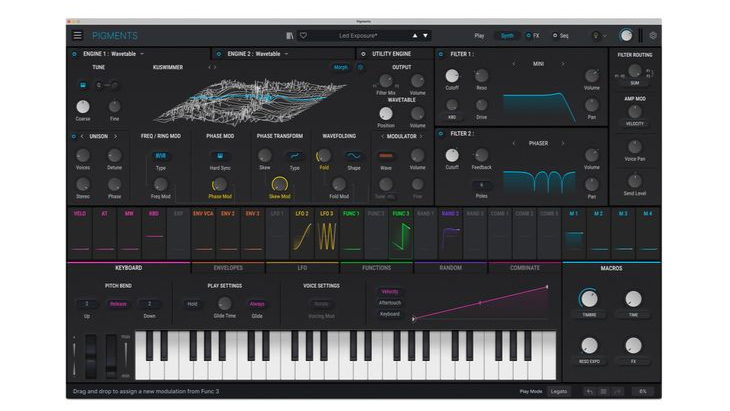
1. Arturia Pigments
Our expert review:
Specifications
Reasons to buy
Reasons to avoid
In terms of sheer bang for your buck, Arturia’s multi-faceted synth plugin is hard to beat. Its multi-engine design enables users to mix and match a multitude of synthesis approaches, including virtual analogue, wavetable, additive, sampling and granular, in order to create hugely rich and complex sounds.
Arturia made its name emulating classic hardware with the V Collection, and much of what the French brand learned from doing so has been deployed in the development of Pigments. This means that the virtual analogue elements are top-notch, evident in the meaty VA engines and an assortment of vintage filter emulations.
Pigments’ biggest selling point, though, is its balance of depth and approachability. There’s a lot to get your teeth into here, including a multitude of modulation tools and a vast array of effects.
If you’d rather not get bogged down in complex sound design, the synth also offers a broad array of highly usable presets and a stripped-back Play View, which enables you to adjust just the core elements of your chosen sound.
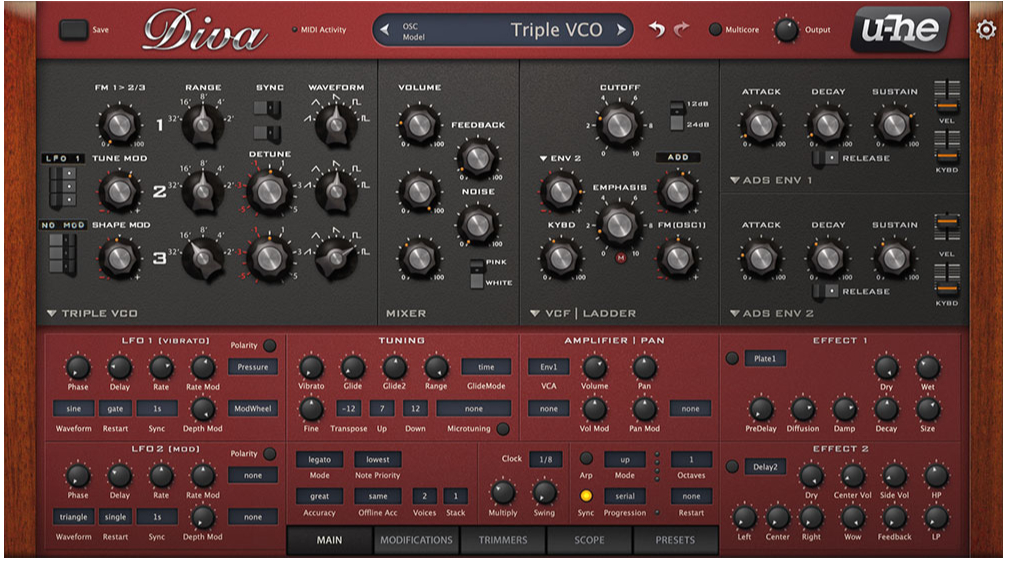
2. u-he Diva
Our expert review:
Specifications
Reasons to buy
Reasons to avoid
There are probably more classic analogue synthesizer emulations peppering the plugin landscape than any other type of virtual instrument, from Native Instruments’ Monark Minimoog to Arturia’s magnificent and increasingly comprehensive V Collection of vintage beauties.
However, standing slightly apart from these is u-he’s venerable Diva. Unlike true emulations like those in the V Collection or GX-80 below, Diva is a semi-modular faux analogue synth that draws influence from not just one, but a full selection of legendary hardware instruments. WIth its roster of oscillators, filters and envelopes, users can mix-and-match vintage sounds or recreate full signal flows that are impossible to distinguish from the real thing.
Released in 2012, Diva later saw the addition of a Roland JP-8000-style digital oscillator option, but for us, it’s all about those VCOs, DCOs and stunning analogue filters.
Read the full u-he Diva review
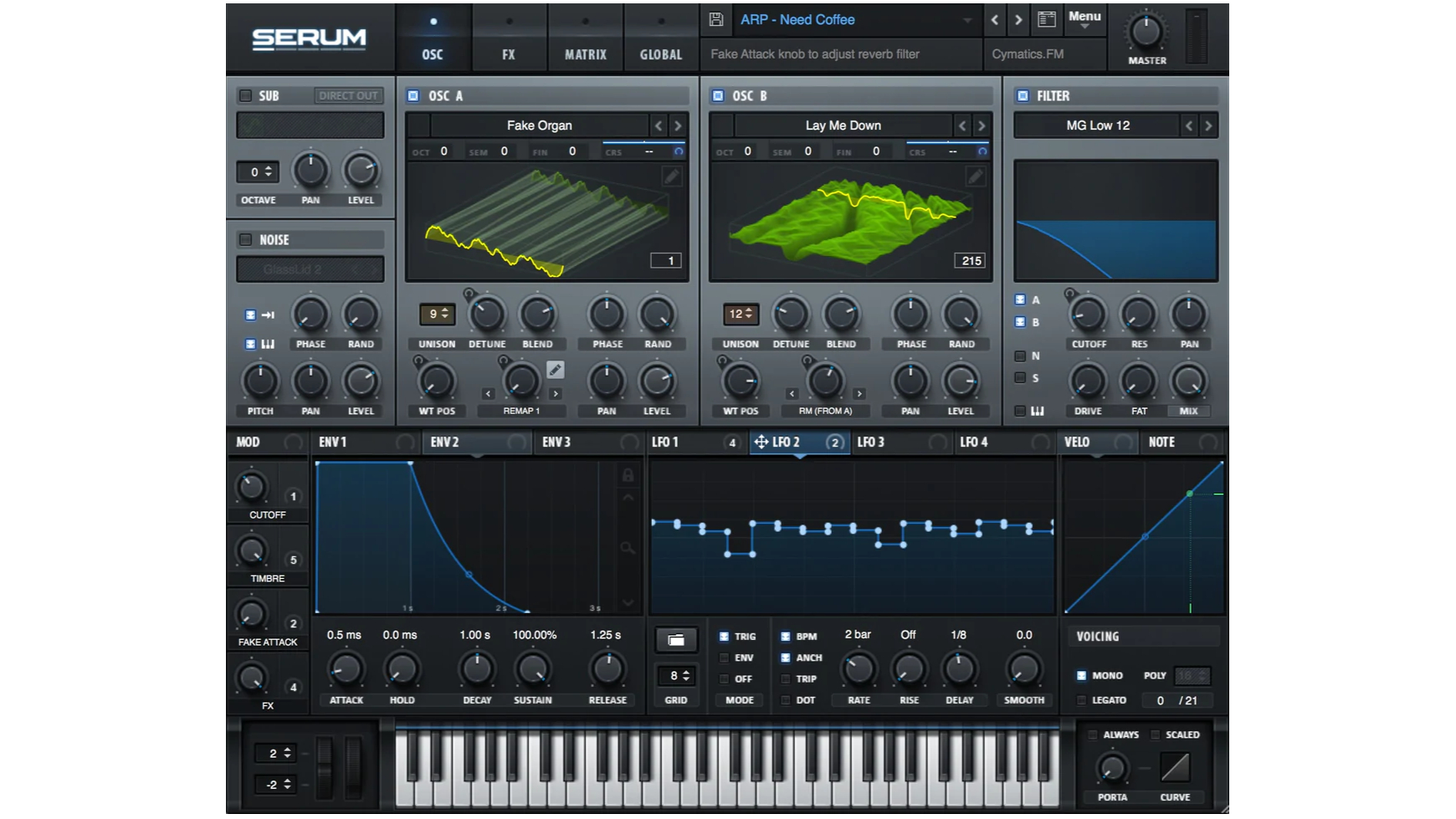
3. Xfer Records Serum
Our expert review:
Specifications
Reasons to buy
Reasons to avoid
Xfer Records’ Serum has been around for almost a decade now, which makes it somewhat ‘vintage’ in plugin terms. In 2023 it still looms large over the plugin landscape, though.
Native Instruments’ Massive might have been the synth that made wavetable synthesis the de facto approach for modern electronic music, but Steve Duda’s Serum took Massive’s blueprint and ran with it, becoming the go-to for producers of EDM and bass music.
There’s so much good stuff here that it’s hard to know where to start, but the headlines include dual wavetable oscillators with a variety of blending and morphing styles, spectacular unison voicing, a full-on wavetable editor, a huge menu of filter types, an intuitive but supercharged modulation system, and a rack of ten stunning effects modules. And the sound? Think punchy, animated basses, scintillating modulated pads, searing leads and evocative FX.
In 2023, there are arguments to be made that other wavetable synths have overtaken Serum in terms of sheer power. NI’s Massive X, for example, is a deeper if less user-friendly instrument. It would be impossible to write a ‘best plugins’ list without a mention for Serum, though. An exemplar of 21st century synth design, it remains nothing short of essential.
Read the full Xfer Records Serum review
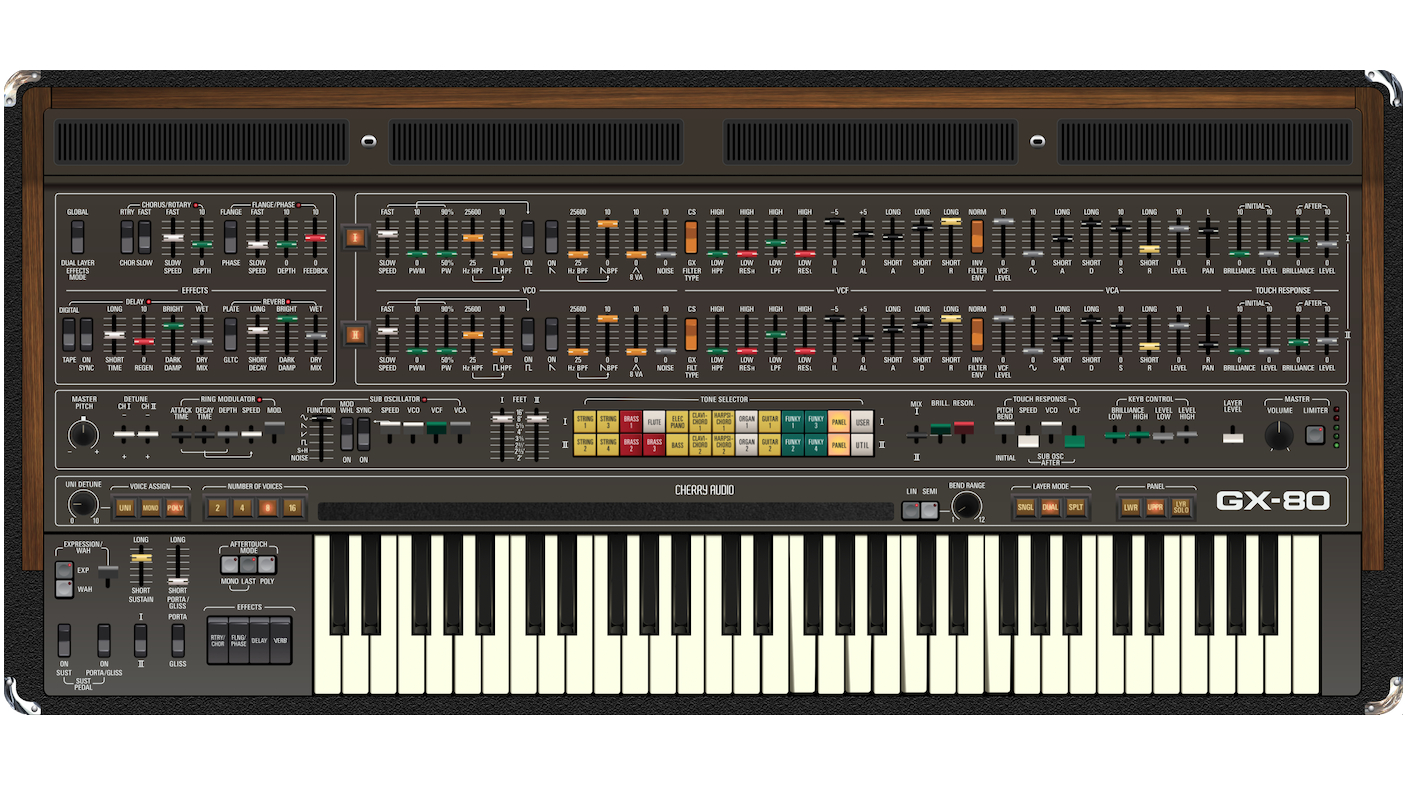
4. Cherry Audio GX-80
Our expert review:
Specifications
Reasons to buy
Reasons to avoid
There’s a huge number of vintage synth emulations out there, and it would be a bit misleading to say that any one is definitively the best of them. For one thing, much of the discussion around whether one emulated synth is better than another comes down to the merits of the original instrument each one is replicating, and that opens a whole other can of worms we don’t have space to clear up here. However, now that we’ve perched ourselves safely atop the proverbial fence, we will highlight one particularly excellent recent example: Cherry Audio’s GX-80.
Cherry Audio has been on a prolific run of form in recent years, releasing a string of impressive vintage-inspired plugins such as Dreamsynth, Elka-X and Miniverse - and that’s just the developer’s 2022 output. GX-80 is another winner, which takes its cues from Yamaha’s analogue behemoth, the CS-80.
The original CS-80 is a rightly lauded classic, regularly associated with the rich cinematic chords of Vangelis’s soundtrack to Blade Runner. Cherry Audio’s take is an extraordinary comprehensive and lifelike emulation, but it also builds on the original by incorporating elements of Yamaha’s rare GX-1, as well as allowing users to split and layer two sounds in a single patch. A smart user interface and generous stock of excellent, usable presets seal the deal.
Read the full Cherry Audio GX-80 review
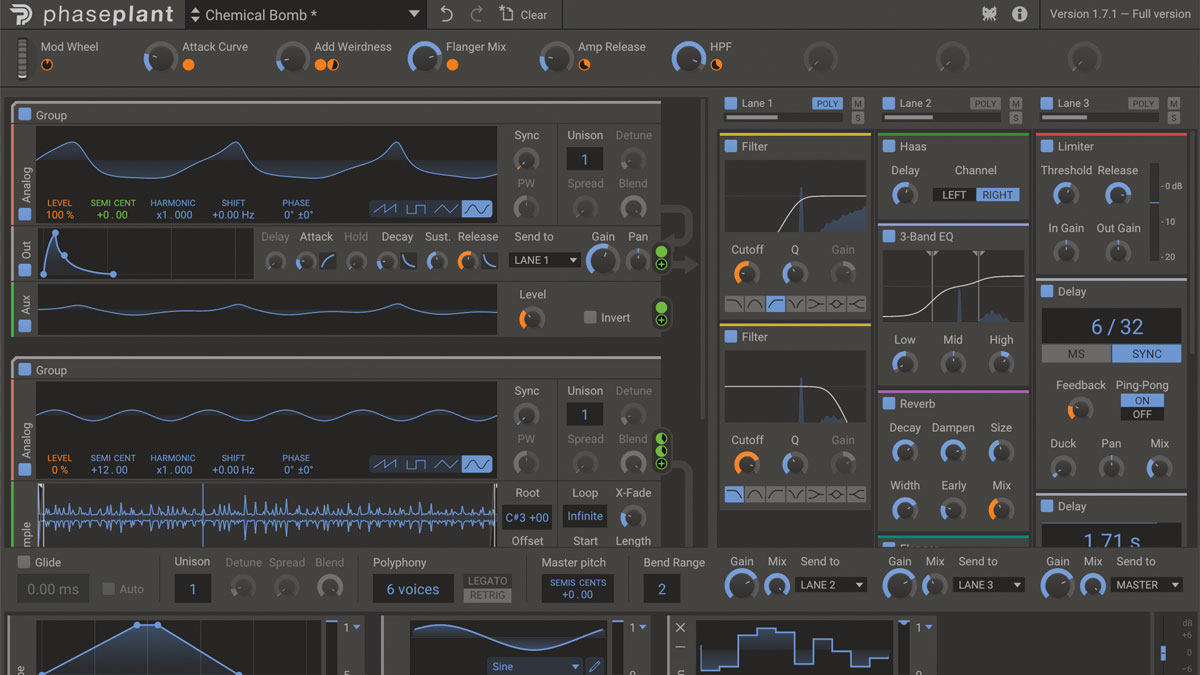
5. Kilohearts Phase Plant
Our expert review:
Specifications
Reasons to buy
Reasons to avoid
Generally when we think of ‘modular’ synths in the software realm, we think of the likes of VCV Rack or Reaktor Blocks (both excellent in their own right), which aim to emulate the functionality of a hardware Eurorack rig. While there are certainly similarities between Kilohearts Phase Plant and the hardware modular realm, what makes this plugin special is that it offers a genuinely unique and software-specific take on the modular concept.
What makes Phase Plant a ‘modular synth’ is the fact that it presents users with an empty workspace and lets them add and connect elements at will, such as sound generating oscillators, samplers, filters and a variety of effects. There’s huge flexibility to how these elements can be routed, too, enabling you to build complex layered patches, set up evolving modulation sequences and apply numerous synthesis approaches.
The flipside to Phase Plant’s depth is that it can be a daunting synth for beginners. There’s a solid crop of impressive presets to explore but, realistically, those willing or prepared to explore the more advanced inner workings of the instrument are the ones likely to get the most out of it.
Read the full Kilohearts Phase Plant review
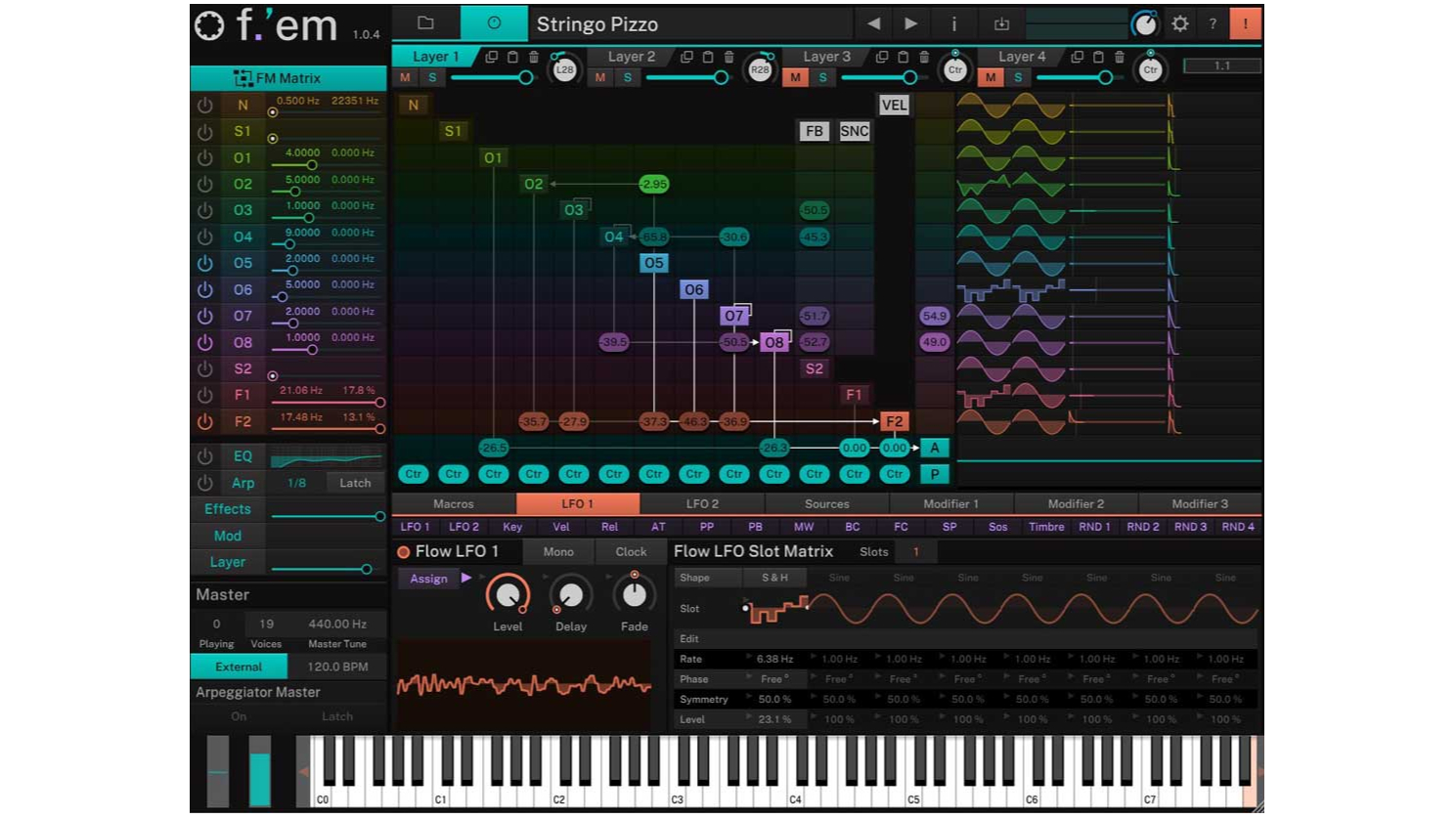
6. Tracktion F.’em
Our expert review:
Specifications
Reasons to buy
Reasons to avoid
Frequency modulation is a digital synthesis approach most closely associated with Yamaha’s ‘80s icon, the DX7. FM synths are notoriously complex and often tricky to program, but nonetheless prized for their ability to create powerful basses, metallic pads and punchy percussive tones.
For a long time, the plugin FM realm was dominated by Native Instruments’ DX7-inspired FM8 which, along with Ableton’s stock Operator and the freeware Dexed, had most producers’ FM needs covered. However, Tracktion’s monumentally powerful F.’em outstrips the capabilities of these predecessors by a substantial margin.
F’.em packs four synthesis layers, each equipped with 11 operators - FM speak for oscillators - including two multi-sample slots, all controlled by a central matrix that allows for a near endless amount of potential modulation routings. All that comes accompanied by an array of LFOs, envelopes, effects and performance features, resulting in a ludicrous level of sound design potential.
The flipside to this is that, despite a colour-coded UI that does its best to keep everything clear, the sheer complexity of F’.em is likely to be off-putting for many users. If you’re willing to brave its depths, though, this is a seriously powerful instrument.
Read the full Tracktion F.’em review
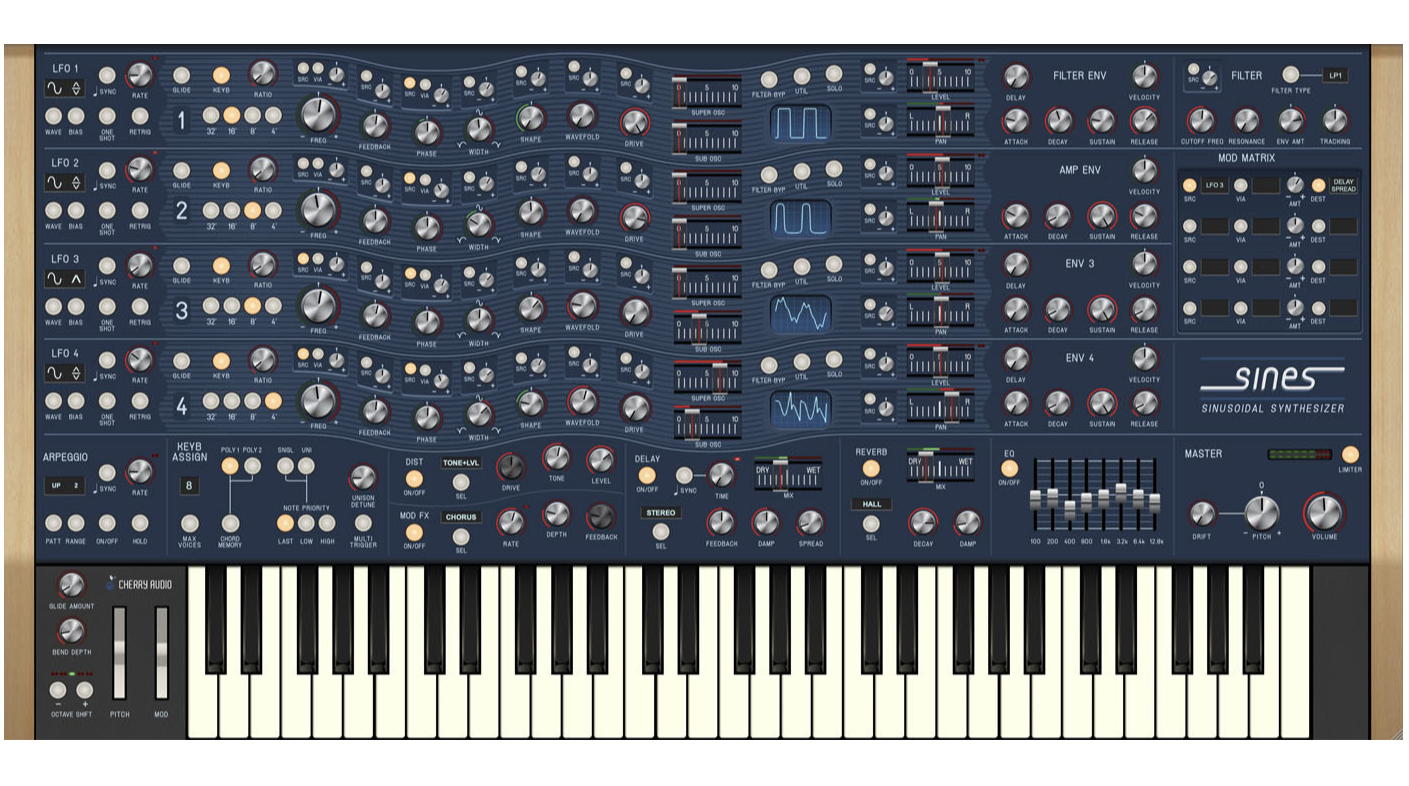
7. Cherry Audio Sines
Our expert review:
Specifications
Reasons to buy
Reasons to avoid
Cherry Audio is best known for its impressive vintage emulations (see GX-80, above), but recent years have also seen the developer branch out with some excellent original instruments, of which Sines is probably the most unique.
As the name suggests, the core elements of Sines are four sine wave oscillators. While this might sound like a rather basic premise, each of these oscillators comes equipped with a variety of controls designed to shift, reshape and combine these simple waves in order to create rich and complex tones. What’s more, the four oscillators can modulate one another.
As a result, Sines has a sonic remit that combines elements of subtractive, additive and FM synthesis, plus a filter section and an assortment of retro effects. Taken as a complete picture, it’s both unique and sonically gorgeous - a genuine must-try.
Read the full Cherry Audio Sines review
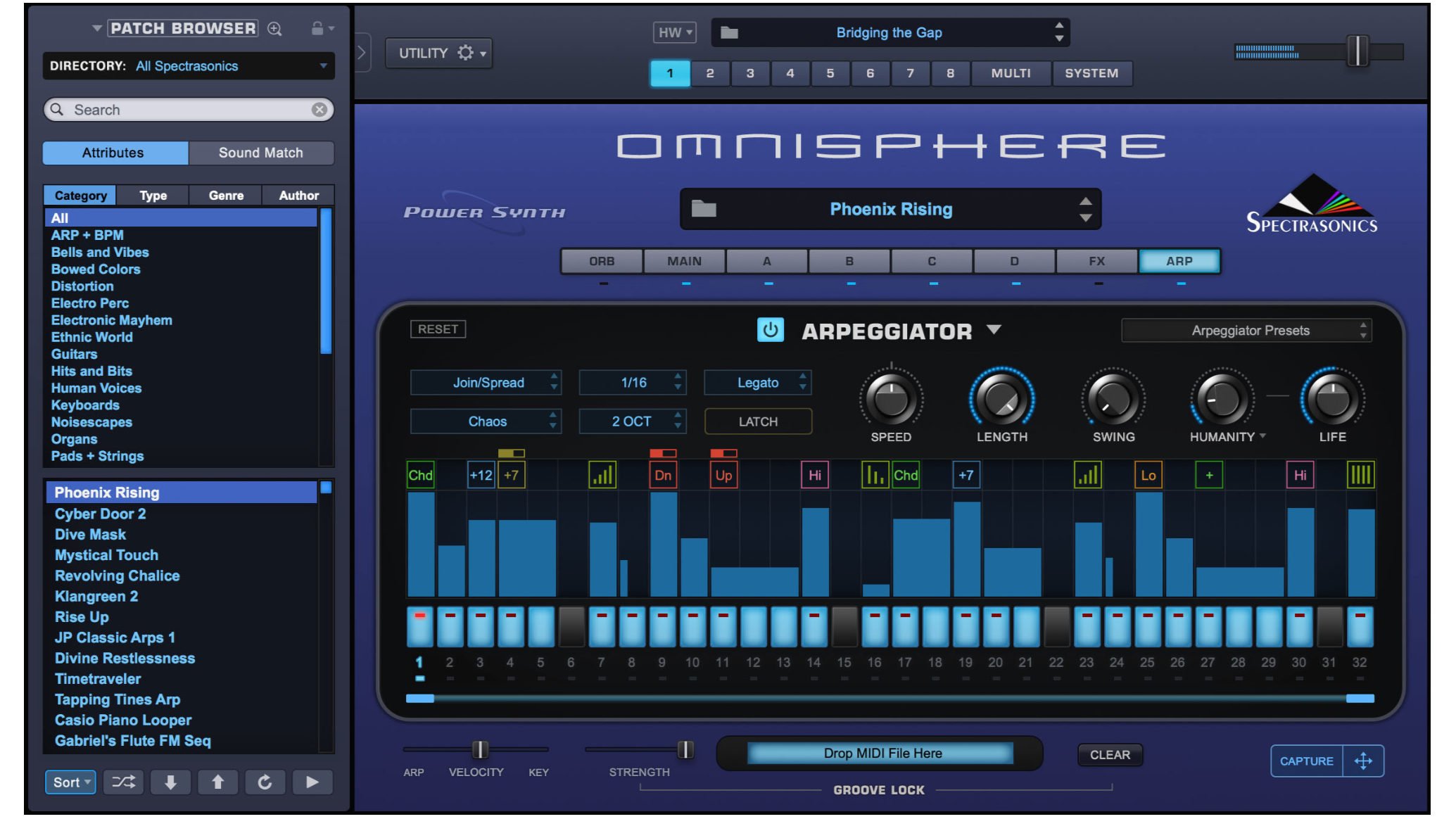
8. Spectrasonics Omnisphere 2
Our expert review:
Specifications
Reasons to buy
Reasons to avoid
Spectrasonics Omnisphere is an absolute monster of a synth. A deep, complex instrument that will hog your hard drive space with its wealth of gorgeous sounds and dominate your productions thanks to its beautiful sonic textures.
Not only does Omnisphere 2 offer over 500 analogue waveforms and digital wavetables, but also more than 30 types for each of its two filters, 58 superb effects and an integrated granular synthesis engine.The headline act, however, are the 65GB of top-notch sample-based sound sources for manipulation within its ridiculously powerful architecture, plus the ability to import your own content.
Epic in scale and sound, Omnisphere 2 is a synth you could spend a lifetime with and still never tire of.
Read the full Spectrasonics Omnisphere 2 review
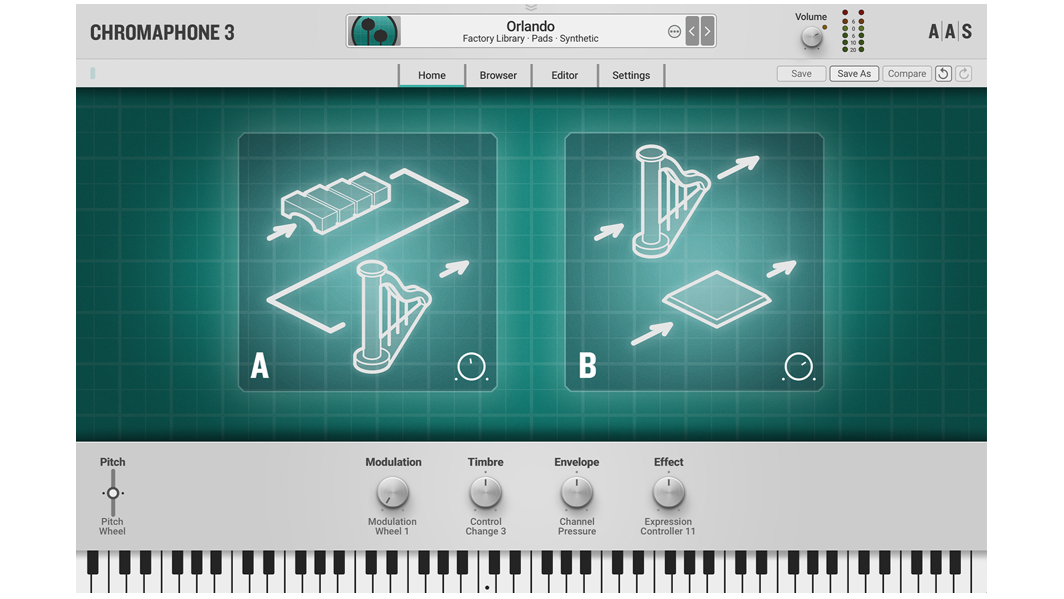
9. Applied Acoustics Chromaphone 3
Our expert review:
Specifications
Reasons to buy
Reasons to avoid
One of the friendliest physical modellers, Chromaphone keeps your head clear from distractions but still lets you get stuck into making the exact sound you’re after. With version 3’s new ‘two layers of layers’ system, Chromaphone now offers double the power.
Chromaphone 3’s Couple feature adds more nuance by processing the two Resonators in parallel or sequence. When coupling is off, the two resonators are activated independently, and the Balance slider controls the volume mix of the two sources. This is closer to how physical modelling synths have worked in the past.
However, when the two Resonators are coupled, they work more like a real instrument - the energy used to activate A feeds into B. Some of B’s energy is then reflected back into A and you get a complex, interactive feedback loop between Resonators. In the coupled configuration, the Balance slider controls how much energy transfer occurs between the two resonators. Great for creating genuinely fresh and unique sounds!
Read the full Chromaphone 3 review
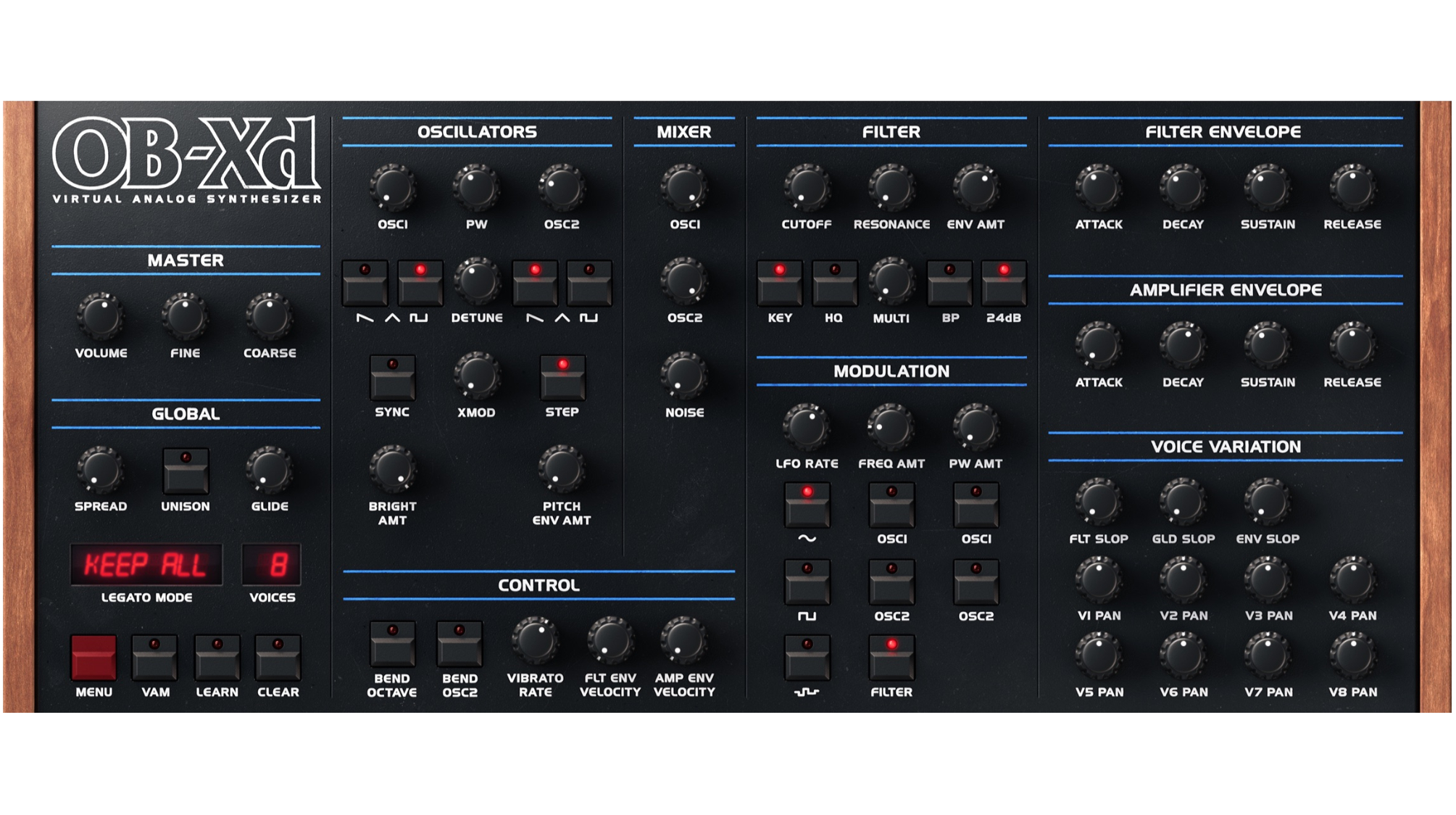
10. DiscoDSP OB-Xd
Our expert review:
Specifications
Reasons to buy
Reasons to avoid
OB-Xd isn’t the flashiest free synth, and nor is it the newest, despite being updated to version 2.5 not too long ago. It remains our favourite freeware synth, though, based largely on its blend of simple usability and excellent sound.
This is an emulation of Tom Oberheim’s classic OB-X polysynth, an analogue classic beloved for its thick, rich sound and easy-to-use interface.
OB-Xd lives up to its inspiration on both fronts. Sonically, this is up there with many paid analogue emulations and, while it lacks the bells and whistles of something like Arturia’s V Collection synths, OB-Xd does build on the design of the original with a morphable filter design and voice variation controls.
While other freeware synths are undoubtedly more adventurous or original than OB-Xd, none are likely to match the broad appeal of this excellent virtual analogue. Download it now and it could quickly become your go-to for rich, vintage poly sounds.
Best synth plugins: Buying advice
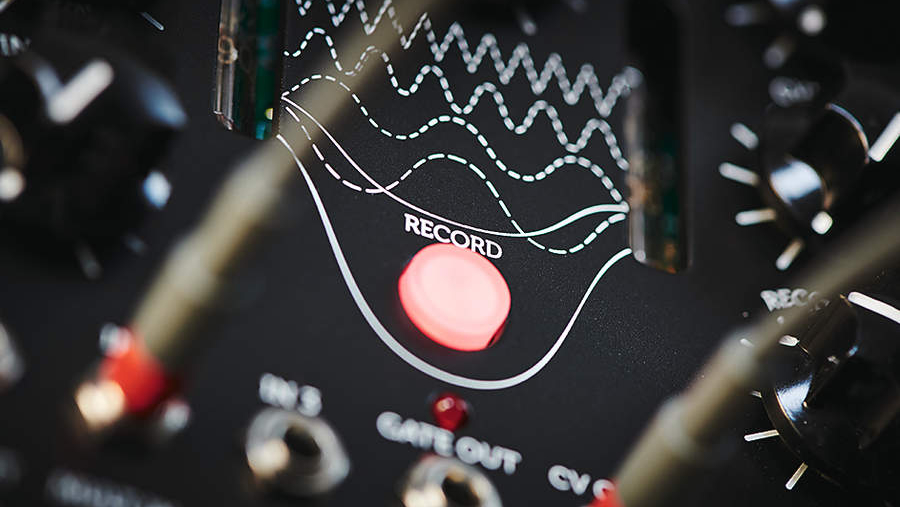
VST, AU and AAX, what's the difference?
There are a variety of plugin standards out there, so before you buy any plugin synth, you need to make sure that your DAW is compatible with it.
On the PC, Steinberg’s VST (Virtual Studio Technology) is by far the most popular, and supported by pretty much all the major DAWs. You can get Mac VSTs, too (though it’s worth mentioning that not all Windows VSTs run on Mac), and Apple also has its own standard called AU (Audio Units). You may see plugins listed as VST 3 too, which is merely the most up-to-date version of the format, although this may not be compatible with some older versions of DAWs.
You may also encounter standards such as AAX and RTAS, both of which are specific to Avid’s Pro Tools software. Similarly, Reason Studios offer Rack Extensions, designed to run specifically within the company’s Reason DAW. DAW developer Bitwig has recently launched a universal format named CLAP, although it’s very early days for this one.
Be sure to check compatibility with your specific computer hardware, too. For example, not all plugin synths currently offer native support for Apple's M1 and M2 Macs, though more and more are being updated to provide this.
What are the main synthesis types?
MusicRadar's got your back
What is a synthesiser? Put simply it’s something that can be used to create - ie, synthesise - sound. There’s more than one way to go about this though, and it’s worth having a rough understanding of the differences when considering what synth to buy.
Subtractive synthesis is the most common type of synthesiser. This starts with a waveform generating a constant sound and then ‘subtracts’ parts of the sound in order to shape it. This is done via filters and an amplifier, both usually shaped using envelopes and LFOs. Subtractive is a broad and flexible church, best for classic synth sounds from the ‘70s onwards.
Virtual analogue synthesis looks to emulate the specific sound and behaviour of an analogue synth. VA synths are usually based on a specific vintage instrument. Virtual analogue and subtractive synths are broadly one and the same, in that most analogue synths are subtractive synths. If you want the sound of a classic Moog, Prophet or Oberheim, VA is the way to go.
Wavetable synthesis uses a layered sample called a wavetable as a sound source. This is essentially a short audio recording, which a synthesizer can scan or move through in order to create evolving sounds. Wavetable synths are incredibly flexible, and have come to dominate electronic music making. They’re especially great for evolving pads, drones and complex basslines.
FM (or frequency modulation) synthesis uses complex modulation to shape sound. It’s most commonly associated with Yamaha’s DX series of synths. FM is great for powerful bass sounds, ‘glassy’ keys, oddball FX and hard-hitting synth drums.
Additive synthesis layers multiple simple sine waves in order to build a sound from the ground up. Due to this ‘building’ approach, additive can be very flexible and, in theory, create pretty much any sound. In practice, it’s great for things like synthesized vocal sounds, complex pads and organ sounds (a drawbar organ works on the same principle as a basic additive synth).
Sample synthesis is a catch-all term for a variety of approaches that use recorded audio as the primary sound source. This could be a simple one-shot sample, a loop or a more complex multisample (wavetable synthesis is technically a type of sample synthesis, too). How these samples are read varies, too, ranging from simple playback to timestretched manipulation or granular synthesis, which breaks a recording down into tiny slices and then rearranges them.
Related buyer's guides
Want all the hottest music and gear news, reviews, deals, features and more, direct to your inbox? Sign up here.

I’m the Deputy Editor of MusicRadar, having worked on the site since its launch in 2007. I previously spent eight years working on our sister magazine, Computer Music. I’ve been playing the piano, gigging in bands and failing to finish tracks at home for more than 30 years, 24 of which I’ve also spent writing about music and the ever-changing technology used to make it.
